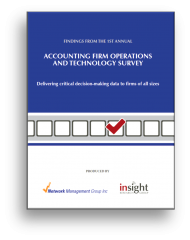Firm Management
2nd Annual Accounting Firm Operations & Technology Survey eBook Released
The eBook features results from 86 survey questions presented using bar charts and tables showing last year’s results against this year. Every survey question features a table revealing how firms of different sizes responded ...
Apr. 09, 2015

Randy Johnston, CEO and Founder, Network Management Group, Inc., Leslie Garrett, PhD, CEO of Insight Research Group, and Brian Tankersley, editor of the publication announce the release of their 2nd Annual Accounting Firm Operations and Technology Survey eBook. The eBook is published in cooperation with Rick Telberg, President and CEO of CPA Trendlines.
“We are very pleased with this year’s survey participation, we have respondents from all 50 states, and our number of respondents doubled over last year’s results, further validating the data,” said Garrett. The 2nd Annual Accounting Firm Operations and Technology Survey eBook features results from 86 survey questions presented using bar charts and tables showing last year’s results against this year. Every survey question features a table revealing how firms of different sizes responded which allows readers to benchmark their practice against others of similar size.
The value-added content in the Accounting Firm Operations and Technology eBook includes:
- Inside the Numbers: For each section of the survey (Demographics, Practice Management, Technology Management, Operating Systems, Computer Hardware, Application Software, File & Date Storage/Management, Remote Access/Internet/Telecommunications, and Technology Decision-making, Annoyances and Trends) our research, analysis and editorial team reports on significant findings in the data. The content in these sections are data-driven based on survey results.
- Consultants Counsel: For each section of the survey our research, analysis and editorial team provides consulting commentary to help readers understand how they might apply the results to their practice, which aids in planning and future decision-making.
- Trend Watch: For select results, our research, analysis and editorial team identified trends that seem to be developing, which gives the reader the opportunity to adjust their operations and technology planning accordingly.
- Thought Leadership: Several of the profession’s most respected thought leaders weigh-in and provide insight into select results. Articles have been contributed by Richard Koreto, Managing Editor of AccountingWEB, Daniel Hood, Editor-in-Chief of Accounting Today, Jim Boomer, CIO and Shareholder, Boomer Consulting Inc., Gail Perry, Editor-in-Chief of CPA Practice Advisor, Rick Telberg of CPA Trendlines, and Bob Scott, Editor-in-Chief of The Progressive Accountant.
New This Year
Trend Watch
With two years of data to report on, our team noticed trends developing in certain operational and technology areas. Where trends are apparent, a Trend Watch section appears in conjunction with the bar chart or table, further illuminating to the reader results that are worth paying additional attention to. “After looking carefully at the results, the editorial team thought that identifying trends was important and convenient for the reader,” said Johnston.
Productivity, Profitability, Risk Mitigation Awards
Respondents of the 2nd Annual Accounting Firm Operations and Technology Survey were asked to identify the accounting practice application software that has had the greatest impact on their firm in each of these three areas: 1) Productivity, 2) Profitability, and 3) Risk Mitigation. Congratulations to the 2015 award-winners:
- Productivity: Intuit QuickBooks
- Profitability: CCH, a Wolters Kluwer business
- Risk Mitigation: Thomson Reuters
The Accounting Firm Operations and Technology eBook is 200 pages in length and features 86 survey questions and overall results for each survey question presented in easy-to-understand charts and tables. The eBook also provides survey results by size of firm broken down by solo practitioners, small firms (1 to 10 employees), mid-sized firms (11 to 49 employees) and large firms (over 50 employees).
